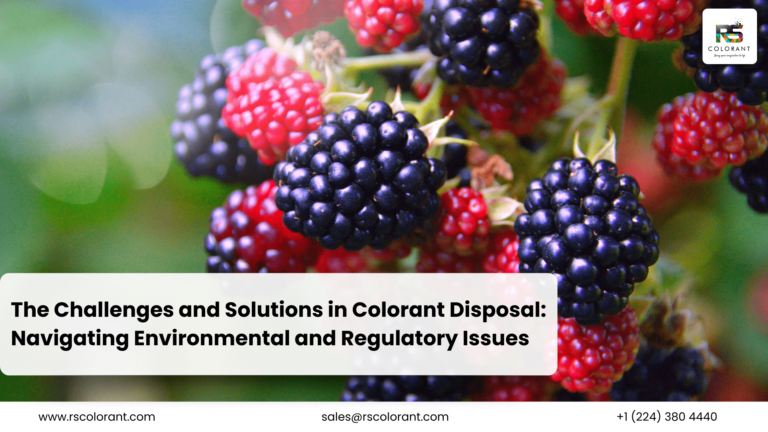The Impact of Colorants on Environmental Sustainability
Color is an essential part of our daily lives, influencing everything from the food we eat to the clothes we wear. But have you ever stopped to think about where these colors come from and their impact on the environment? Let’s dive into the world of colorants and explore how they affect environmental sustainability.
Types of Colorants
Natural Colorants
Natural colorants are derived from plants, animals, and minerals. Examples include beetroot for red, turmeric for yellow, and indigo for blue. These colorants have been used for centuries, dating back to ancient civilizations.
Synthetic Colorants
Synthetic colorants, on the other hand, are created through chemical processes. These include azo dyes, anthraquinone dyes, and many others. They became popular in the 19th century due to their vibrant colors and cost-effectiveness.
Differences Between Natural and Synthetic Colorants
The main differences lie in their sources, production methods, and environmental impacts. Natural colorants are renewable and biodegradable, whereas synthetic colorants often rely on non-renewable resources and can be more harmful to the environment.
Production Processes
Extraction of Natural Colorants
Extracting natural colorants typically involves harvesting the source material, such as plants or insects, and processing it to obtain the desired pigment. This process is generally less harmful to the environment.
Synthesis of Synthetic Colorants
Synthetic colorants are produced through complex chemical reactions. These processes often require significant energy and can produce hazardous waste, contributing to pollution.
Environmental Impact of Production Processes
While natural colorant production is more sustainable, it can still have environmental impacts, such as land use and water consumption. Synthetic colorant production, however, is often associated with higher levels of pollution and waste.
Usage in Various Industries
Food Industry
Colorants are used extensively in the food industry to enhance the appearance of products. Natural colorants, like beet juice, are preferred for their health benefits, while synthetic colorants are often used for their vibrant hues.
Textile Industry
The textile industry relies heavily on both natural and synthetic dyes. Synthetic dyes are popular for their durability and wide range of colors, but they pose significant environmental challenges.
Cosmetic Industry
Cosmetics use colorants to achieve various shades in products like lipsticks, eyeshadows, and nail polishes. The industry is gradually shifting towards more natural and sustainable options.
Other Industries
Colorants are also used in pharmaceuticals, plastics, and paper industries, among others. Each sector faces unique challenges in balancing colorant performance with environmental sustainability.
Environmental Impact of Natural Colorants
Renewable Sources
Natural colorants are typically sourced from renewable resources like plants and minerals, making them more sustainable in the long run.
Biodegradability
One of the key advantages of natural colorants is their biodegradability. They break down more easily in the environment, reducing long-term pollution.
Lesser Toxicity
Natural colorants generally have lower toxicity levels compared to their synthetic counterparts, posing fewer risks to human health and the environment.
Environmental Impact of Synthetic Colorants
Non-Renewable Sources
Synthetic colorants often rely on petroleum-based chemicals, which are non-renewable and contribute to environmental degradation.
Pollution and Toxicity
The production and disposal of synthetic colorants can lead to significant pollution, including water contamination and soil degradation. Many synthetic dyes are also toxic to aquatic life.
Persistence in the Environment
Synthetic colorants can persist in the environment for long periods, leading to accumulation and potential ecological damage.
Case Studies
Impact of Indigo Dye in the Textile Industry
Indigo dye, commonly used in denim production, has significant environmental impacts, including water pollution from dyeing processes. However, sustainable alternatives are being explored.
Use of Beetroot Extract in the Food Industry
Beetroot extract is a popular natural colorant in the food industry, known for its vibrant red hue and health benefits. Its production is relatively eco-friendly.
Synthetic Dyes in Cosmetics
Many cosmetics rely on synthetic dyes for their vibrant colors. However, the industry is facing increasing pressure to adopt more sustainable practices.
Regulations and Policies
Government Regulations on Colorants
Governments worldwide are implementing stricter regulations on the use and disposal of colorants to minimize environmental impact.
International Policies
International bodies, such as the European Union, have established guidelines and standards for colorant use in various industries.
Industry Standards
Industry standards are evolving to incorporate sustainability criteria, encouraging companies to adopt more eco-friendly practices.
Innovations and Alternatives
Advances in Natural Colorant Production
Innovations in natural colorant production are making them more viable for commercial use, including improved extraction methods and enhanced color stability.
Eco-Friendly Synthetic Alternatives
Researchers are developing synthetic colorants that are less harmful to the environment, such as biodegradable dyes and those made from renewable resources.
Role of Biotechnology
Biotechnology is playing a crucial role in creating sustainable colorants, including genetically engineered plants that produce vibrant pigments.
Consumer Awareness and Choices
Educating Consumers on Colorants
Increasing consumer awareness about the environmental impact of colorants is essential for driving demand for sustainable products.
Impact of Consumer Choices
Consumers can influence industry practices by choosing products made with eco-friendly colorants and supporting brands committed to sustainability.
Trends in Eco-Friendly Products
There is a growing trend towards eco-friendly products, with more companies offering sustainably colored goods to meet consumer demand.
Sustainable Practices in Industries
Sustainable Sourcing
Industries are adopting sustainable sourcing practices, such as using renewable resources and supporting fair trade initiatives.
Waste Management and Recycling
Effective waste management and recycling practices are crucial for reducing the environmental impact of colorant production and disposal.
Case Studies of Sustainable Companies
Companies like Patagonia and Lush are leading the way in sustainable colorant use, setting examples for others to follow.
Challenges and Barriers
Economic Challenges
Switching to sustainable colorants can be costly, posing economic challenges for companies, especially small businesses.
Technological Barriers
Developing and implementing new technologies for sustainable colorant production can be technically challenging and require significant investment.
Regulatory Hurdles
Navigating complex regulatory landscapes can be difficult for companies trying to adopt sustainable practices, especially in different international markets.
Future Outlook
Trends in Colorant Technology
The future of colorant technology looks promising, with ongoing research and development aimed at creating more sustainable and effective options.
Potential for Sustainable Growth
There is significant potential for sustainable growth in the colorant industry, driven by consumer demand and regulatory pressure.
Vision for a Colorant-Sustainable Future
A sustainable future for colorants involves a combination of natural and eco-friendly synthetic options, supported by innovative technologies and informed consumer choices.
Conclusion
In conclusion, colorants play a vital role in various industries, but their environmental impact cannot be ignored. By embracing sustainable practices, supporting eco-friendly alternatives, and educating consumers, we can pave the way for a more sustainable future. It’s up to all of us—industries, consumers, and policymakers—to make choices that protect our planet.
FAQs
What are natural colorants? Natural colorants are pigments derived from natural sources like plants, animals, and minerals. They are renewable and biodegradable, making them more environmentally friendly than synthetic colorants.
How do synthetic colorants affect the environment? Synthetic colorants often rely on non-renewable resources and can lead to pollution and toxicity in the environment. They can persist in ecosystems, causing long-term damage.
Can synthetic colorants be made more eco-friendly? Yes, researchers are developing eco-friendly synthetic colorants using renewable resources and biodegradable materials to reduce their environmental impact.
What can consumers do to support sustainability in colorants? Consumers can choose products made with natural or eco-friendly synthetic colorants, support brands committed to sustainability, and educate themselves about the environmental impact of colorants.
What are some examples of eco-friendly colorant practices? Examples include using natural dyes from renewable sources, implementing sustainable sourcing and waste management practices, and developing biodegradable synthetic colorants.




